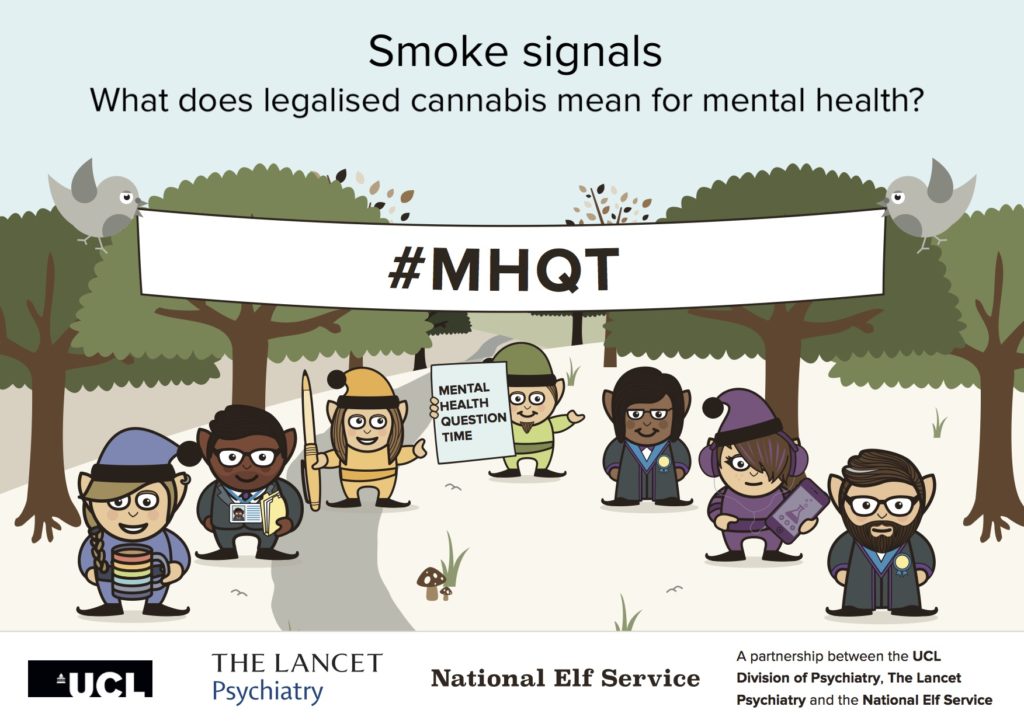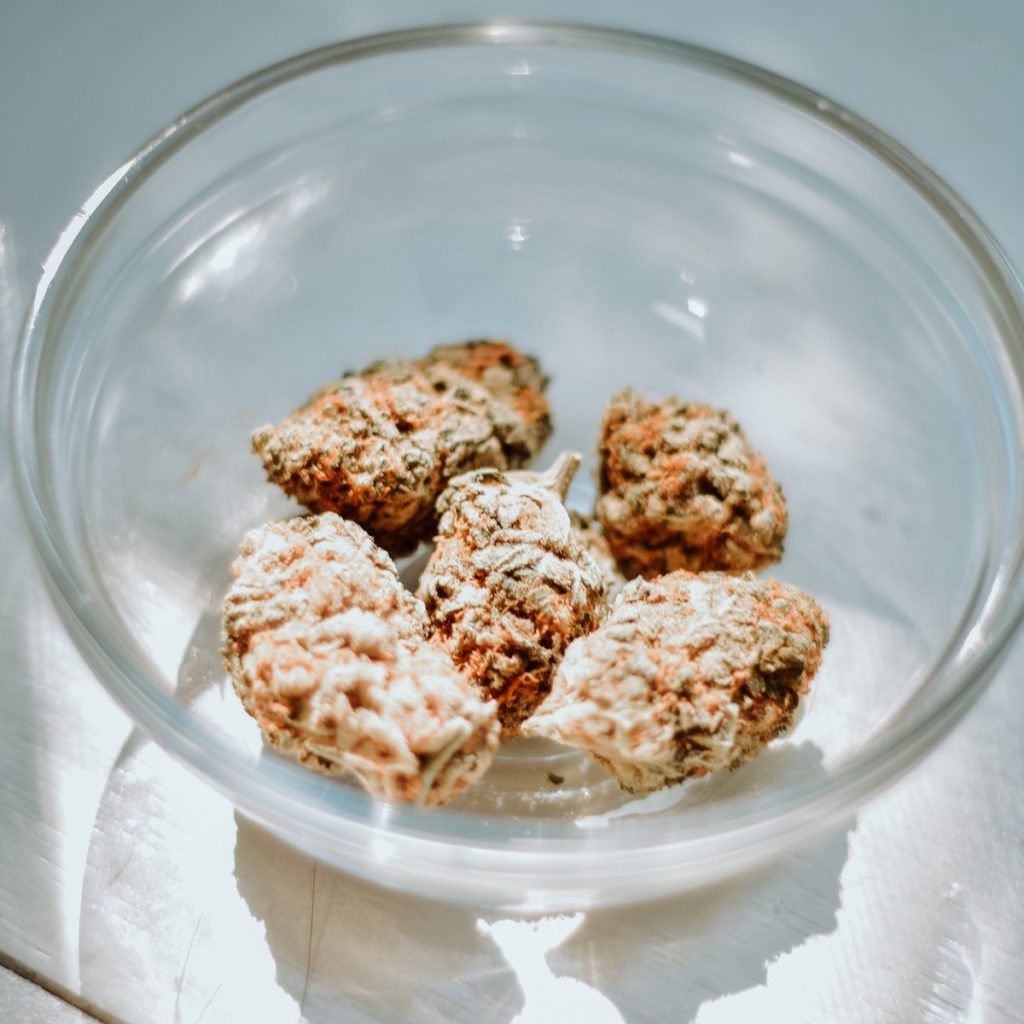
Whether cannabis or its derivatives are effective treatments for psychiatric conditions has generated a lot of interest recently. However to date, legal restrictions have largely prevented big, well-designed trials from being conducted. As a result, while in the last two years there have been several reviews published (e.g. Walsh et al. 2017; Rong et al. 2017; Lim, See, & Lee 2017; Khoury et al. 2017) synthesising the evidence base for cannabis and cannabinoids in psychiatric populations, as well as numerous opinion pieces discussing various aspects of using cannabis for medical purposes, there have been only a handful of published randomised controlled trials (RCTs). Two of these investigated the anti-psychotic effects of cannabidiol (CBD) and only included a small number of trial participants (N=88 and N=36). I covered the larger of these two RCTs in a previous Mental Elf Blog, which found only a very modest effect of CBD as an adjunct to anti-psychotic treatment.
So while at the moment the interest in this topic somewhat outstrips the evidence, things appear to be changing. In the US there are now several planned or ongoing studies of CBD or synthetic cannabinoids such as Dronabinol for treating psychiatric illnesses, many of which have moderate or large planned sample sizes (N>100). Meanwhile, a large RCT (N=300) of CBD as an anti-psychotic in people at high risk of psychosis is being conducted by a team at the IOPPN here in the UK. However, it will be quite a few years before the results of many of these trials are published. So for the time being at least, we need to focus on what is currently known.
Ahead of a Mental Health Question Time on cannabis and mental health on Wednesday 26th September, this blog describes a paper by Turna, Patterson, & Ameringen (2017), who conducted a comprehensive (but not systematic) review of the current evidence regarding the effectiveness of cannabis and cannabinoids in anxiety, mood, and related psychiatric conditions.

Get your FREE tickets now for the Mental Health Question Time in London on Wednesday 26th September.
Methods
The authors conducted a review of treatment effects of cannabis and cannabinoids on social anxiety disorder and generalised anxiety disorder, major depressive disorder, bipolar disorder, post-traumatic stress disorder (PTSD), obsessive-compulsive disorder (OCD), trichotillomania, and Tourette’s syndrome.
The authors searched five electronic databases (PubMed, MEDLINE, Web of Science, PsychINFO, and Google Scholar) in February 2017. They present a narrative synthesis and no meta-analyses, which is likely due to the wide range of mental health conditions included, cannabinoids tested, and the small number of studies in any one area, with studies being generally of low quality.
Results
Due to the small number of trials in populations with the targeted psychiatric conditions, the authors included evidence from both healthy participants and animal models. In these, there is some evidence that CBD and the synthetic cannabinoid Dronabinol may reduce anxiety levels. THC meanwhile has produced very mixed results, with some reporting increased anxiety and others reporting a reduction. While these studies are typically small, the authors conclude that there is tentative evidence that CBD and Dronabinol may act as an anxiolytic.
Amongst the studies in psychiatric populations, two studies involved patients with social anxiety disorder (SAD). Both studies investigated the effects of CBD on self-reported anxiety levels. In both, the CBD group reported less anxiety than placebo as well as healthy controls if used. However, the review authors did not report the magnitude of the effect and only one study featured a task designed to elicit anxiety. The other was a neuroimaging study and relied on the MRI scanner to induce anxiety. Moreover, both studies were very small (n=24 and n=10) and therefore limited in generalisability.
Two studies targeted generalised anxiety disorder (GAD), both using the synthetic cannabinoid Nabilone and both published in 1981. Although both studies reported an effect in the experimental phase, the benefits were mixed and the numbers very small (N=4).
Two observational studies were identified, one published and one unpublished, for plant-based cannabis for PTSD. Both studies followed participants (N= 80 approximately and 29) who had started using medical cannabis. By the end of the observational period (2 years and 11.3 months), most reported fewer symptoms. Similarly, the review included a pilot study of THC for PTSD (N=10) that reported reduced symptoms by the end of the trial. Finally, two other studies investigate Nabilone (n=104 and 47) using a chart review method and both found significant improvement in symptoms by the end of the review period. However, none featured a comparison group not receiving cannabinoids and none, therefore, were randomised. One other study was identified of Nabilone that used a cross-sectional design that also found a benefit. But as with other studies, the sample was small (N=10).
Two studies have trialled THC for major depressive disorder (N=8 and 13), but both report no benefit and one found greater dysphoria from treatment. The review authors also report on case reports of plant-based cannabis and Dronabinol, but the quality of evidence was extremely low. The quality of evidence is similar in bipolar disorder, where the authors identified one observational study of plant-based cannabis and two case reports of CBD. Overall, the standard of evidence is currently extremely poor.
A small randomised controlled trial (N=24) lasting 6 weeks of THC treatment for Tourette’s syndrome was identified, which found participants in the experimental group showed reduced tic severity and motor tic intensity by treatment end. One study of Dronabinol has been published for OCD (N=2) and one for Trichotillomania (N=14), both of which found some benefit. However, as with studies in other conditions, the sample sizes were very small and there was no control group.

Small is beautiful? Not when it comes to medical research. This narrative review found a number of small studies that suggest cannabis or cannabinoids may be beneficial for anxiety, mood, and other related disorders. BUT, these studies are small, often without a control group, and are therefore likely to be at high risk of bias.
Conclusions
This review found some evidence that cannabis or cannabinoids may be beneficial for anxiety, mood, and other related disorders. However, the overall quality of the evidence was poor and extremely limited. Few studies have looked at psychiatric populations, and most of these were very small, while only observational studies had larger sample sizes. Many trials featured only an experimental group and no comparison, and most had other deficiencies such as using a single dose of the treatment or a short follow-up period that may not allow potentially adverse side-effects to be identified. Secondly, some of the better designed studies in this review investigated healthy participants rather than patients. While these studies suggest that some cannabinoids may have an anxiolytic effect, this does not mean participants with anxiety disorders will really experience much benefit from using them.
Strengths and limitations
This study was a narrative review rather than a systematic review, and the authors do not report important aspects of their methods, such as screening procedures. They also do not give an assessment of the overall quality of the evidences or an evaluation of the risk of bias. The effect sizes in individual studies are often not reported, and there are no meta-analyses of overall treatment effects. Presumably at least some of these limitations are due to the low quality and quantity of the evidence so far published.
Other issues include that many of the studies did not feature a comparison group and participants were not randomised to receive the treatment or a control. This was true of the larger studies, which were observational or used a chart-review method. Therefore, any evidence of benefit in these studies cannot be relied on as participants may have improved without treatment. Meanwhile, many of the randomised studies were pilots or feasibility studies and featured very small groups and so lack generalisability.
Finally, the association between THC and mental illness is well established, and large trials with long follow-up periods are needed to explore potentially severe adverse consequences of medical cannabis and its derivatives.

This review does not give any assessment of the overall quality of the included studies or any evaluation of the risk of bias of the small trials.
Implications for practice
Overall, at this stage there is hope that CBD especially, and perhaps some synthetic cannabinoids, could be effective for treating some anxiety and mood disorders. However, currently the quality of the evidence is too low to provide clear evidence of any benefit. Currently no recommendations for clinical practice can be made. Good quality trials are required before cannabis or cannabinoids can be considered as an option for treatment.

At present, we have only low quality evidence looking at cannabis as a treatment for anxiety or mood disorders, which is insufficient to make any recommendations for clinical practice.
Conflicts of interest
None
Links
Primary paper
Turna J, Patterson B, Van Ameringen M. (2017) Is cannabis treatment for anxiety, mood, and related disorders ready for prime time? Depress Anxiety; 34:1006. [PubMed abstract]
Other references
Khoury JM, Neves MCLD, Roque MAV, Queiroz DAB, Corrêa de Freitas AA, de Fátima Â, Moreira FA, Garcia FD. (2017) Is there a role for cannabidiol in psychiatry? World J. Biol. Psychiatry 20, 1–16. [PubMed abstract]
Lim K, See YM, Lee J. (2017) A systematic review of the effectiveness of medical cannabis for psychiatric, movement and neurodegenerative disorders. Clin Psychopharmacol Neurosci. 2017;15:301–312
Rong C, Lee Y, Carmona NE, et al. (2017) Cannabidiol in medical marijuana: research vistas and potential opportunities. Pharmacol Res.;121:213–8. [PubMed abstract]
Walsh Z, Gonzales R, Crosby K, Carroll C, Bonn-Miller MO. (2016) Medical cannabis and mental health: a systematic review (PDF). Clin. Psychol. Rev.
Photo credits
- Photo by Sharon McCutcheon on Unsplash
- Photo by Vlad Tchompalov on Unsplash
- Photo by Hello I’m Nik on Unsplash
- Photo by Jacalyn Beales on Unsplash
